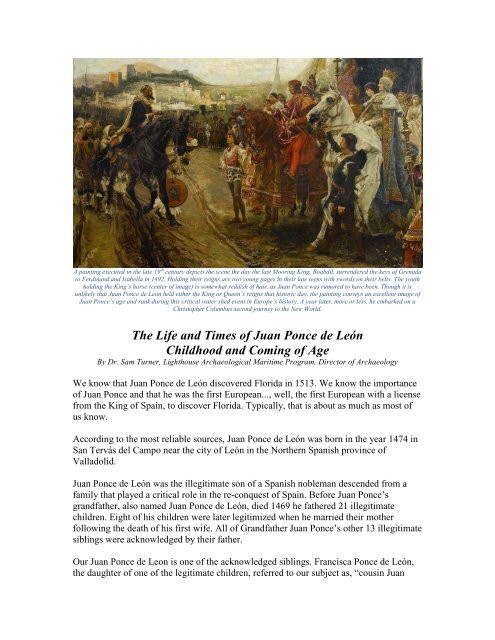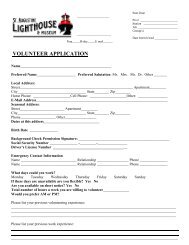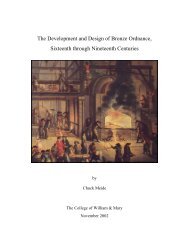Everyone knows that Juan Ponce de Leon discovered Florida in ...
Everyone knows that Juan Ponce de Leon discovered Florida in ...
Everyone knows that Juan Ponce de Leon discovered Florida in ...
- No tags were found...
You also want an ePaper? Increase the reach of your titles
YUMPU automatically turns print PDFs into web optimized ePapers that Google loves.
A pa<strong>in</strong>t<strong>in</strong>g executed <strong>in</strong> the late 19 th century <strong>de</strong>picts the scene the day the last Moor<strong>in</strong>g K<strong>in</strong>g, Boabdil, surren<strong>de</strong>red the keys of Grenada<br />
to Ferd<strong>in</strong>and and Isabella <strong>in</strong> 1492. Hold<strong>in</strong>g their reigns are two young pages <strong>in</strong> their late teens with swords on their belts. The youth<br />
hold<strong>in</strong>g the K<strong>in</strong>g’s horse (center of image) is somewhat reddish of hair, as <strong>Juan</strong> <strong>Ponce</strong> was rumored to have been. Though it is<br />
unlikely <strong>that</strong> <strong>Juan</strong> <strong>Ponce</strong> <strong>de</strong> León held either the K<strong>in</strong>g or Queen’s reigns <strong>that</strong> historic day, the pa<strong>in</strong>t<strong>in</strong>g conveys an excellent image of<br />
<strong>Juan</strong> <strong>Ponce</strong>’s age and rank dur<strong>in</strong>g this critical water shed event <strong>in</strong> Europe’s history. A year later, more or less, he embarked on a<br />
Christopher Columbus second journey to the New World.<br />
The Life and Times of <strong>Juan</strong> <strong>Ponce</strong> <strong>de</strong> León<br />
Childhood and Com<strong>in</strong>g of Age<br />
By Dr. Sam Turner, Lighthouse Archaeological Maritime Program, Director of Archaeology<br />
We know <strong>that</strong> <strong>Juan</strong> <strong>Ponce</strong> <strong>de</strong> León <strong>discovered</strong> <strong>Florida</strong> <strong>in</strong> 1513. We know the importance<br />
of <strong>Juan</strong> <strong>Ponce</strong> and <strong>that</strong> he was the first European..., well, the first European with a license<br />
from the K<strong>in</strong>g of Spa<strong>in</strong>, to discover <strong>Florida</strong>. Typically, <strong>that</strong> is about as much as most of<br />
us know.<br />
Accord<strong>in</strong>g to the most reliable sources, <strong>Juan</strong> <strong>Ponce</strong> <strong>de</strong> León was born <strong>in</strong> the year 1474 <strong>in</strong><br />
San Tervás <strong>de</strong>l Campo near the city of León <strong>in</strong> the Northern Spanish prov<strong>in</strong>ce of<br />
Valladolid.<br />
<strong>Juan</strong> <strong>Ponce</strong> <strong>de</strong> León was the illegitimate son of a Spanish nobleman <strong>de</strong>scen<strong>de</strong>d from a<br />
family <strong>that</strong> played a critical role <strong>in</strong> the re-conquest of Spa<strong>in</strong>. Before <strong>Juan</strong> <strong>Ponce</strong>’s<br />
grandfather, also named <strong>Juan</strong> <strong>Ponce</strong> <strong>de</strong> León, died 1469 he fathered 21 illegitimate<br />
children. Eight of his children were later legitimized when he married their mother<br />
follow<strong>in</strong>g the <strong>de</strong>ath of his first wife. All of Grandfather <strong>Juan</strong> <strong>Ponce</strong>’s other 13 illegitimate<br />
sibl<strong>in</strong>gs were acknowledged by their father.<br />
Our <strong>Juan</strong> <strong>Ponce</strong> <strong>de</strong> <strong>Leon</strong> is one of the acknowledged sibl<strong>in</strong>gs. Francisca <strong>Ponce</strong> <strong>de</strong> León,<br />
the daughter of one of the legitimate children, referred to our subject as, “cous<strong>in</strong> <strong>Juan</strong>
<strong>Ponce</strong> <strong>de</strong> León the A<strong>de</strong>lantado of Bim<strong>in</strong>i and the island of <strong>Florida</strong>.” There are no known<br />
references to <strong>Juan</strong> <strong>Ponce</strong>’s mother so <strong>in</strong> all probability she was common and not of the<br />
nobility. She resi<strong>de</strong>d <strong>in</strong> the town of San Tervás <strong>de</strong>l Campo where a number of resi<strong>de</strong>nts<br />
were relations, bar<strong>in</strong>g the <strong>Ponce</strong> <strong>de</strong> León name. Later, some of these family members<br />
would jo<strong>in</strong> <strong>Juan</strong> <strong>in</strong> the New World.<br />
<strong>Juan</strong> <strong>Ponce</strong> <strong>de</strong> León was born <strong>in</strong> a country at war and <strong>in</strong>to a marshal culture. Though<br />
illegitimate he was still educated and received tra<strong>in</strong><strong>in</strong>g <strong>in</strong> the art of fight<strong>in</strong>g.<br />
The year <strong>Juan</strong> <strong>Ponce</strong> <strong>de</strong> <strong>Leon</strong> was born was also the year Isabella came to the throne of<br />
Castile spark<strong>in</strong>g the War of Castilian Succession (1474-1479). The war was a struggle for<br />
the crown between the supporters of <strong>Juan</strong>a la Beltraneja, daughter of Castile’s late<br />
monarch Henry IV and wife of K<strong>in</strong>g Alfonso V of Portugal, and those of Henry's half<br />
sister, Isabella who had recently married Ferd<strong>in</strong>and of Aragon. Despite a few successes<br />
by the supporters of <strong>Juan</strong>a, the lack of military aggressiveness of Afonso V and the<br />
Portuguese <strong>de</strong>feat at the Battle of Toro <strong>in</strong> 1476 led to the dis<strong>in</strong>tegration of <strong>Juan</strong>a's<br />
alliance.<br />
The war conclu<strong>de</strong>d <strong>in</strong> 1479 with the sign<strong>in</strong>g of the Treaty of Alcáçovas which recognized<br />
Isabella and Ferd<strong>in</strong>and as k<strong>in</strong>gs of Castile and granted Portugal hegemony <strong>in</strong> the Atlantic,<br />
with the exception of the Canary Islands. <strong>Juan</strong>a lost her right to the throne of Castile and<br />
rema<strong>in</strong>ed <strong>in</strong> Portugal. Hav<strong>in</strong>g secured the Castilian throne, Isabella and Ferd<strong>in</strong>and were<br />
free to concentrate their military efforts on the rema<strong>in</strong><strong>in</strong>g Moorish lands <strong>in</strong> southern<br />
Spa<strong>in</strong>.<br />
As a young boy, possibly between the ages of 8 and 10, <strong>Ponce</strong> <strong>de</strong> <strong>Leon</strong> became the page<br />
of a Spanish knight of Calatrava named Pedro Núñez <strong>de</strong> Guzmán.<br />
The Spanish military or<strong>de</strong>r of Calatrava, foun<strong>de</strong>d <strong>in</strong> 1157, took its name from a castle<br />
named Calatrava captured from the Moors <strong>in</strong> 1147. The <strong>in</strong>itial purpose of the or<strong>de</strong>r was<br />
to hold Calatrava aga<strong>in</strong>st all Moorish counterattacks but they soon began to take an<br />
offensive role. The or<strong>de</strong>r had become very wealthy and powerful by the time <strong>Juan</strong> <strong>Ponce</strong><br />
was born <strong>in</strong> 1474 hold<strong>in</strong>g sway over 56 comman<strong>de</strong>ries and 16 priories. However, its<br />
existence as an <strong>in</strong><strong>de</strong>pen<strong>de</strong>nt military or<strong>de</strong>r came to an end <strong>in</strong> 1487, when <strong>Juan</strong> <strong>Ponce</strong> was<br />
the 13-year-old page of Núñez <strong>de</strong> Guzmán, after K<strong>in</strong>g Ferd<strong>in</strong>and obta<strong>in</strong>ed a papal <strong>de</strong>gree<br />
to br<strong>in</strong>g the or<strong>de</strong>r un<strong>de</strong>r his direct command.<br />
In 1492 the Christian troops of Ferd<strong>in</strong>and and Isabella brought to an end nearly a century<br />
of Moorish K<strong>in</strong>gdoms and the Moorish culture of al-Andalus. Now 18 <strong>Juan</strong> <strong>Ponce</strong> was<br />
present at and participated <strong>in</strong> the historic capture of the Moorish K<strong>in</strong>gdom. <strong>Juan</strong> <strong>Ponce</strong>’s<br />
uncle Rodrigo <strong>Ponce</strong> <strong>de</strong> León, the father of Francisca <strong>Ponce</strong>, played a prom<strong>in</strong>ent role <strong>in</strong><br />
this conflict.<br />
<strong>Juan</strong> <strong>Ponce</strong> <strong>de</strong> León, aged n<strong>in</strong>eteen, with the help of his master Pedro Núñez <strong>de</strong> Guzmán,<br />
obta<strong>in</strong>ed passage <strong>in</strong> the Spanish fleet <strong>that</strong> sailed for the New World <strong>in</strong> 1493. This was<br />
Christopher Columbus’s second voyage to the New World and it resulted <strong>in</strong> the found<strong>in</strong>g
of La Isabella on the Island of Española <strong>discovered</strong> the previous year. Consequently,<br />
<strong>Ponce</strong> witnessed and participated <strong>in</strong> the found<strong>in</strong>g of Spanish civilization <strong>in</strong> the New<br />
World.<br />
<strong>Juan</strong> <strong>Ponce</strong> <strong>de</strong> León managed to survive, while many Spanish did not. This put him on a<br />
slowly ascend<strong>in</strong>g career path. Between 1494 and 1498 he likely lived <strong>in</strong> the <strong>in</strong>terior of the<br />
island of Española with the Ta<strong>in</strong>o Indians, the natural <strong>in</strong>habitants. Dur<strong>in</strong>g this time a<br />
number of important events occurred which would have affected <strong>Juan</strong> <strong>Ponce</strong> and <strong>in</strong><br />
which he may well have participated. In 1495, largely as a result of friction between the<br />
Ta<strong>in</strong>o and the Spanish who roamed about the <strong>in</strong>terior, the first major pitched battle<br />
between a large body of Ta<strong>in</strong>os and the Spanish occurred. This battle, known as the<br />
Battle of the Vega Real, saw the Spanish, led by Bartolomé Columbus, one of<br />
Christopher Columbus’s younger brothers, <strong>de</strong>feat the Indians us<strong>in</strong>g a two-pronged attack<br />
strategy. <strong>Juan</strong> <strong>Ponce</strong> learned a great <strong>de</strong>al about the Ta<strong>in</strong>o culture dur<strong>in</strong>g this period,<br />
<strong>in</strong>clud<strong>in</strong>g a certa<strong>in</strong> amount of language, fight<strong>in</strong>g techniques, agriculture, and food ways.<br />
All this <strong>in</strong>formation would help him succeed <strong>in</strong> future battles with the Ta<strong>in</strong>os as well as<br />
<strong>in</strong> his future ranch<strong>in</strong>g, m<strong>in</strong><strong>in</strong>g, and settl<strong>in</strong>g en<strong>de</strong>avors.<br />
N<strong>in</strong>e years later <strong>in</strong> 1504, <strong>Ponce</strong> comman<strong>de</strong>d a company of Spanish soldiers from<br />
the city of Santo Dom<strong>in</strong>go, the new capital and pr<strong>in</strong>cipal port of the island of Española.<br />
These were engaged <strong>in</strong> the subjugation of the last <strong>in</strong><strong>de</strong>pen<strong>de</strong>nt Indian prov<strong>in</strong>ce on the<br />
island, Higüey. The prov<strong>in</strong>ce, <strong>in</strong> eastern Española on the Mona Passage, was given to<br />
<strong>Juan</strong> <strong>Ponce</strong> to command follow<strong>in</strong>g Spanish victory <strong>in</strong> 1505. There he foun<strong>de</strong>d the town<br />
of Salvaleón <strong>de</strong> Higüey and its port, Puerto <strong>de</strong> Yuma, at the mouth of the Yuma River.<br />
Sometime between 1504 and 1506, aged thirty to thirty-two, <strong>Juan</strong> <strong>Ponce</strong> married <strong>Leon</strong>or,<br />
the daughter of an <strong>in</strong>nkeeper <strong>in</strong> Santo Dom<strong>in</strong>go.<br />
At this time, 1505-1506, <strong>Ponce</strong> had news of gold on the neighbor<strong>in</strong>g island, San<br />
<strong>Juan</strong> Bautista, today known as Puerto Rico, which lay across the Mona Passage. He<br />
organized a prospect<strong>in</strong>g party and foun<strong>de</strong>d a gold m<strong>in</strong><strong>in</strong>g settlement called Caparra <strong>in</strong> the
hills overlook<strong>in</strong>g what is today called San <strong>Juan</strong> Bay. By 1508 he had solidified and<br />
signed a m<strong>in</strong><strong>in</strong>g contract with Nicolas <strong>de</strong> Ovando, the governor of Española. The contract<br />
gave him the right to m<strong>in</strong>d but did not bestow any political office.<br />
All was go<strong>in</strong>g well until the arrival of Diego Columbus, the new governor of the Indies <strong>in</strong><br />
August 1509. Diego Columbus was the el<strong>de</strong>st son and heir of Christopher Columbus.<br />
Diego was <strong>in</strong>censed <strong>that</strong> K<strong>in</strong>g Ferd<strong>in</strong>and had essentially violated the contract <strong>that</strong> was<br />
drawn up between Christopher Columbus and the Catholic Monarchs at Santa Fe<br />
previous to his father’s voyage <strong>in</strong> 1492. Accord<strong>in</strong>g to the terms of the contract,<br />
Christopher Columbus, and his heirs, had the right to appo<strong>in</strong>t political officials on those<br />
lands <strong>discovered</strong> dur<strong>in</strong>g his voyages. Diego consi<strong>de</strong>red <strong>Ponce</strong>’s m<strong>in</strong><strong>in</strong>g contract with<br />
K<strong>in</strong>g Ferd<strong>in</strong>and an <strong>in</strong>fr<strong>in</strong>gement of those rights.<br />
Upon his arrival <strong>in</strong> the Santo Dom<strong>in</strong>go, Diego Columbus appo<strong>in</strong>ted political officials to<br />
the island of Puerto Rico. These were <strong>Juan</strong> Cerón and Miguel Díaz <strong>de</strong> Aux. These men<br />
arrived <strong>in</strong> Puerto Rico <strong>in</strong> October 1509, with hundreds of immigrant followers <strong>in</strong>tent on<br />
ga<strong>in</strong><strong>in</strong>g wealth through m<strong>in</strong><strong>in</strong>g and other bus<strong>in</strong>esses with Indian labor.<br />
K<strong>in</strong>g Ferd<strong>in</strong>and respon<strong>de</strong>d to the situation on Puerto Rico by appo<strong>in</strong>t<strong>in</strong>g <strong>Juan</strong> <strong>Ponce</strong><br />
governor. The <strong>de</strong>cree was placed secretly on a vessel <strong>in</strong> Santo Dom<strong>in</strong>go by Miguel <strong>de</strong><br />
Pasamonte, the k<strong>in</strong>g’s treasurer on Española, and taken to Puerto Rico where it was<br />
<strong>de</strong>livered to <strong>Juan</strong> <strong>Ponce</strong>. <strong>Juan</strong> Cerón was adamant the k<strong>in</strong>g had no authority to appo<strong>in</strong>t<br />
political officials and would not acknowledge <strong>Ponce</strong> as governor, consequently <strong>Ponce</strong><br />
had Cerón and Miguel Díaz <strong>de</strong>ta<strong>in</strong>ed and sent to Spa<strong>in</strong> un<strong>de</strong>r arrest to expla<strong>in</strong> their<br />
attitu<strong>de</strong> to the k<strong>in</strong>g <strong>in</strong> person.<br />
Diego Columbus sued the k<strong>in</strong>g <strong>in</strong> the Cortes, or advisory council, over numerous issues<br />
<strong>in</strong>clud<strong>in</strong>g <strong>that</strong> of appo<strong>in</strong>t<strong>in</strong>g political officials <strong>in</strong> lands <strong>discovered</strong> by his father. He won<br />
on a number of counts <strong>in</strong>clud<strong>in</strong>g the right to appo<strong>in</strong>t his own political officials. <strong>Juan</strong><br />
<strong>Ponce</strong>’s tenure as governor was therefore short lived. Forced by the Cortes to remove<br />
<strong>Juan</strong> <strong>Ponce</strong> from office, the k<strong>in</strong>g granted him a license to explore and discover the lands<br />
reputed to lie to the north and <strong>in</strong> particular the Island of Bim<strong>in</strong>i. This led to <strong>Ponce</strong>’s 1513<br />
voyage of discovery to <strong>Florida</strong>.<br />
As <strong>Florida</strong> celebrates 500 years <strong>in</strong> 2013, the St. August<strong>in</strong>e Lighthouse & Museum stands<br />
as a witness to many historical events <strong>that</strong> occurred dur<strong>in</strong>g those 500 years. We look<br />
forward to offer<strong>in</strong>g you a glimpse and shar<strong>in</strong>g <strong>that</strong> history, our artifacts and our beautiful<br />
lighthouse.




